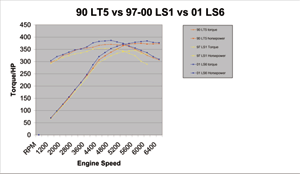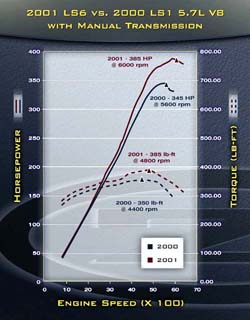Development
History
|
 |
|
|
This power and torque graph of the 1990-92 LT5 vs. the 1997-00 LS1 vs. the 2001 LS6 is a revealing piece of information. There’s no doubt that the LS6 either matches or exceeds the early version of the LT5 in all areas of the torque and power curves. In the mid-range the LS6 generates noticeably more torque. Also evident is that, in spite of a more aggressive camshaft, bigger intake ports and more plenum volume, the LS6 equals or exceeds the LS1 in low-end torque. Graphic:
author. Click Image For Larger View & PDF Print File |
|
|
.. |
General Motor’s Generation Three Small-Block engine family debuted in the 1997 Corvette as the LS1, a 346 cu.in., 345hp V8. A slightly de-tuned version (305 or 320hp) showed-up in the Camaro Z28 and Firebird Trans Am the following year. The Gen IIIs began high-volume production in 1999 as the iron-block, 4.8L, 5.3L and 6.0L engines that debuted in Silverado pick-ups that year. Gen III’s are now used in all GM full-size, light-trucks and
SUVs.
The LS1 was a home run right out of the box. With cutting-edge engine technology, it made one SAE net-hp-per-cu.in. and did that with a high-level of refinement. For this, Ward’s Auto World put the LS1 on its "Ten Best Engines" list in 1998 and 1999.
The LS1 is discussed in more detail in an article at
http://www.idavette.net/hib/ls1c.html That story might be a good reference for anyone reading this article. Additional LS1 technical information is in a Society of Automotive Engineers booklet: 1997 GM 5.7 Liter LS1 V8 Engine by Richard W. Amann, Mark A. Damico, Brian Green, Charles J. Hahn, Ameer Haider, John W. Juriga and Creighton A. Mantey, SAE paper #97015, February 1997. Interesting,
non-techie information about LS1’s development is available in the late Jim Schefter’s outstanding book, All Corvettes are Red , Simon and Schuster, 1996.
"Doctor" John Juriga, Assistant Chief Engineer for Gen III Passenger Car Engines at GM’s Powertrain Division, has been "on the program" since the Gen III’s beginning in 1992. He’s my kinda guy because he characterizes an engine as the "...heart and soul of a Corvette." and describes GMPT’s work on Corvette engines as the "ruthless pursuit of power." Clearly, those philosophies drove Juriga and his team of engineers as they began work on the LS6.
"Even before we put the LS1 into production," Juriga told this Registry writer, "we were considering performance improvements. We had ideas of what we needed to do. Also the Corvette group (the GM entity which develops the entire vehicle) had given us their targets for the engine’s performance and we’d been looking at what other people on the outside were doing with the LS1.
"After the engine was in production in early ’97, we brought the program that would result in a higher output version up to full speed."
Juriga paused while he checked his computer files, then said. "It was June 25th, 1997 when we had our 2001 concept initiation.
"We started developing a plan based on Corvette’s goal of 375 horsepower. They also wanted improvements in 0-60 and quarter-mile performance of three-tenths. We studied their targets and came back saying, ‘We think we can meet those targets, based on the development we’ve done to date, but we may not be able to do it if we have to meet the LEV
(Low Emission Vehicle, required in California for 2000 and nationwide for 2001) emissions standard.
We started developing a plan based on Corvette’s goal of 375 horsepower. They also wanted improvements in 0-60 and quarter-mile performance of three-tenths. We studied their targets and came back saying, ‘We think we can meet those targets, based on the development we’ve done to date, but we may not be able to do it if we have to meet the LEV
(Low Emission Vehicle) emissions standard. (required in California for 2000 and nationwide for 2001).
 |
|
|
Graphing the ’00 LS1s power and torque against the LS6 demonstrates some interesting facts. First, past its power peak the LS6 still does well, whereas the LS1 was not worth winding past 6000. Second, even though the LS6 has bigger heads and cam, it gives nothing away to the LS1, even at 1000 rpm and by 2250 rpm it’s gaining. Graphic: Chevrolet Communications/Black Dog
Design - Click Image For Larger View |
|
"There was some talk of getting a deviation from LEV for the Corvette, but frankly, I wasn’t crazy about it. I discussed this with the Corvette guys. Personally, I wanted this product to not have any excuses. I wanted it to have the performance and not have us say, ‘Oh, but, it’s a guzzler.’ or ‘But it doesn’t meet current emissions requirements and we had to get a deviation for that.’ We held the bar to ourselves. We wanted to make the power and try and meet the emissions, but we were a little unsure at first if we could do that."
As Juriga’s staff of engineers began full-scale development, the first major challenge was the camshaft and cylinder head package. Both pieces were significant evolutions from the LS1 parts and the work took about a year during 1997 and 1998. The other major task was a redesign of the bare block (engineers call them "cylinder cases") to improve its "bay-to-bay" breathing and its strength. That took place in mid-to-late 1998. The final major challenge was a sort of "surprise" late in the program. Once prototype engines were available for installation in vehicles, race track testing demonstrated oil control and consumption problems in certain extreme duty situations. The problem, discovered in the fall of ’98, took about nine months to solve. The LS6’s final development and validation was during mid-to-late 1999. Pilot engines were built in the first quarter of 2000 and the first production units that
spring
In the end, John Juriga’s reservations about power and meeting LEV were unfounded. Not only did the LS6 meet Corporate Average Fuel Economy (CAFE) requirements and LEV but it did so while exceeding the Corvette platform team’s goal of 375hp.
So went the ruthless pursuit of power.


